清华大学:《分子生物学》课程PPT教学课件(基因ene)第十五章 转座子(Transposons)
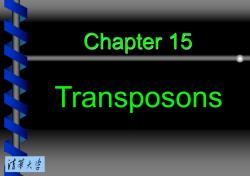
Chapter 15 Transposons 清第大当
Chapter 15 Transposons
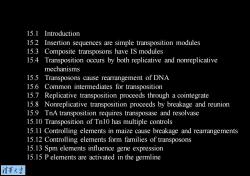
15.1 Introduction 15.2 Insertion sequences are simple transposition modules 15.3 Composite transposons have IS modules 15.4 Transposition occurs by both replicative and nonreplicative mechanisms 15.5 Transposons cause rearrangement of DNA 15.6 Common intermediates for transposition 15.7 Replicative transposition proceeds through a cointegrate 15.8 Nonreplicative transposition proceeds by breakage and reunion 15.9 TnA transposition requires transposase and resolvase 15.10 Transposition of Tn10 has multiple controls 15.11 Controlling elements in maize cause breakage and rearrangements 15.12 Controlling elements form families of transposons 15.13 Spm elements influence gene expression 15.15 P elements are activated in the germline 清苇大当
15.1 Introduction 15.2 Insertion sequences are simple transposition modules 15.3 Composite transposons have IS modules 15.4 Transposition occurs by both replicative and nonreplicative mechanisms 15.5 Transposons cause rearrangement of DNA 15.6 Common intermediates for transposition 15.7 Replicative transposition proceeds through a cointegrate 15.8 Nonreplicative transposition proceeds by breakage and reunion 15.9 TnA transposition requires transposase and resolvase 15.10 Transposition of Tn10 has multiple controls 15.11 Controlling elements in maize cause breakage and rearrangements 15.12 Controlling elements form families of transposons 15.13 Spm elements influence gene expression 15.15 P elements are activated in the germline

15.1 Introduction Transposon is a DNA sequence able to insert itself at a new location in the genome (without any sequence relationship with the target locus) 情莘大学
Transposon is a DNA sequence able to insert itself at a new location in the genome (without any sequence relationship with the target locus). 15.1 Introduction
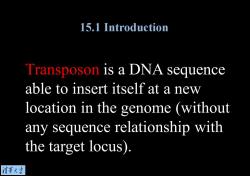
15.1 Introduction Transposon is a DNA sequence able to insert itself at a new location in the genome (without any sequence relationship with the target locus) 清苇大当
Transposon is a DNA sequence able to insert itself at a new location in the genome (without any sequence relationship with the target locus). 15.1 Introduction
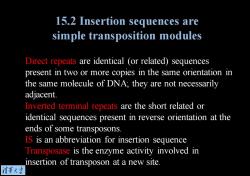
15.2 Insertion sequences are simple transposition modules Direct repeats are identical (or related)sequences present in two or more copies in the same orientation in the same molecule of DNA;they are not necessarily adjacent. Inverted terminal repeats are the short related or identical sequences present in reverse orientation at the ends of some transposons. IS is an abbreviation for insertion sequence Transposase is the enzyme activity involved in insertion of transposon at a new site. 清菜大当
Direct repeats are identical (or related) sequences present in two or more copies in the same orientation in the same molecule of DNA; they are not necessarily adjacent. Inverted terminal repeats are the short related or identical sequences present in reverse orientation at the ends of some transposons. IS is an abbreviation for insertion sequence Transposase is the enzyme activity involved in insertion of transposon at a new site. 15.2 Insertion sequences are simple transposition modules
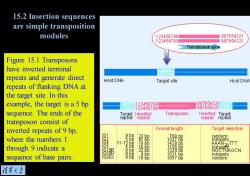
15.2 Insertion sequences are simple transposition modules 123456789 987654321 123456789 987654321 Transposase gene Figure 15.1 Transposons have inverted terminal ATGCA TACGT repeats and generate direct Host DNA Target site Host DNA repeats of flanking DNA at the target site.In this example,the target is a 5 bp 88楞78 987654321ATCC 987654321TACG sequence.The ends of the Target Iwerted Transposon Irverted Target repeat repeat repeat repeat transposon consist of inverted repeats of 9 bp, Overall length Target selection random where the numbers 1 退 3F186298 品品品5 bb hotspots AAAN2OTTT through 9 indicate a R吧GCN sequence of base pairs. hotspots 的 random 清菜大当
Figure 15.1 Transposons have inverted terminal repeats and generate direct repeats of flanking DNA at the target site. In this example, the target is a 5 bp sequence. The ends of the transposon consist of inverted repeats of 9 bp, where the numbers 1 through 9 indicate a sequence of base pairs. 15.2 Insertion sequences are simple transposition modules
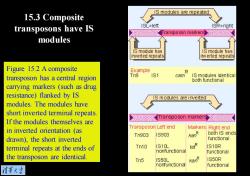
IS modules are repeated 15.3 Composite transposons have IS ISL=left SR=nght Transposon markers modules IS module has IS module has inverted repeats inv erted repeats Figure 15.2 A composite Example transposon has a central region Tn9 1S1 cam IS modules identical both functional carrying markers (such as drug resistance)flanked by IS IS modules are irverted modules.The modules have short inverted terminal repeats. Transposon markers If the modules themselves are in inverted orientation (as Transposon Left end Markers Right end Tn903 1S903 karR both IS ends drawn),the short inverted functional terminal repeats at the ends of Tn10 1S10L te IS10R nonfunctional functional the transposon are identical Tn5 1S50L ⑧ 1S50R nonfunctional functional 清菜大当
Figure 15.2 A composite transposon has a central region carrying markers (such as drug resistance) flanked by IS modules. The modules have short inverted terminal repeats. If the modules themselves are in inverted orientation (as drawn), the short inverted terminal repeats at the ends of the transposon are identical. 15.3 Composite transposons have IS modules
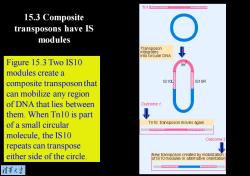
Tn102222222223 *333 15.3 Composite transposons have IS modules Transposon integrates into circular DNA Figure 15.3 Two IS10 modules create a composite transposon that 1S10L 1S10R can mobilize any region of DNA that lies between Outcome 1 them.When Tn10 is part of a small circular Tn10 transposon moves again 222223232% E3& molecule,the IS10 Outcome 2 repeats can transpose either side of the circle. New transposon created by mobilization of IS 10 modules in altemative onentatior 清第大当 ✉ 2222
Figure 15.3 Two IS10 modules create a composite transposon that can mobilize any region of DNA that lies between them. When Tn10 is part of a small circular molecule, the IS10 repeats can transpose either side of the circle. 15.3 Composite transposons have IS modules
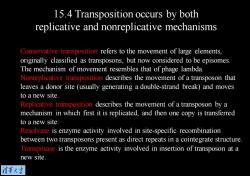
15.4 Transposition occurs by both replicative and nonreplicative mechanisms Conservative transposition refers to the movement of large elements, originally classified as transposons,but now considered to be episomes. The mechanism of movement resembles that of phage lambda. Nonreplicative transposition describes the movement of a transposon that leaves a donor site (usually generating a double-strand break)and moves to a new site. Replicative transposition describes the movement of a transposon by a mechanism in which first it is replicated,and then one copy is transferred to a new site. Resolvase is enzyme activity involved in site-specific recombination between two transposons present as direct repeats in a cointegrate structure. Transposase is the enzyme activity involved in insertion of transposon at a new site. 清菜大当
Conservative transposition refers to the movement of large elements, originally classified as transposons, but now considered to be episomes. The mechanism of movement resembles that of phage lambda. Nonreplicative transposition describes the movement of a transposon that leaves a donor site (usually generating a double-strand break) and moves to a new site. Replicative transposition describes the movement of a transposon by a mechanism in which first it is replicated, and then one copy is transferred to a new site. Resolvase is enzyme activity involved in site-specific recombination between two transposons present as direct repeats in a cointegrate structure. Transposase is the enzyme activity involved in insertion of transposon at a new site. 15.4 Transposition occurs by both replicative and nonreplicative mechanisms
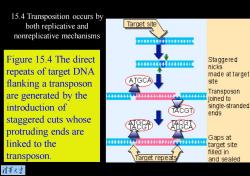
15.4 Transposition occurs by both replicative and Target site nonreplicative mechanisms 1HHH111HHHHHH Figure 15.4 The direct Staggered +++H++H repeats of target DNA nicks made at target flanking a transposon ATGCA site are generated by the Transposon joined to introduction of single-stranded ends staggered cuts whose 8 protruding ends are Gaps at linked to the target site filled in transposon. arget repeats and sealed 清菜大兰
Figure 15.4 The direct repeats of target DNA flanking a transposon are generated by the introduction of staggered cuts whose protruding ends are linked to the transposon. 15.4 Transposition occurs by both replicative and nonreplicative mechanisms
按次数下载不扣除下载券;
注册用户24小时内重复下载只扣除一次;
顺序:VIP每日次数-->可用次数-->下载券;
- 清华大学:《分子生物学》课程PPT教学课件(基因ene)第十四章 重组和修复(Recombination and repair).ppt
- 清华大学:《分子生物学》课程PPT教学课件(基因ene)第十三章 DNA复制(DNA replication).ppt
- 清华大学:《分子生物学》课程PPT教学课件(基因ene)第十二章 复制子(The replicon).ppt
- 清华大学:《分子生物学》课程PPT教学课件(基因ene)第十一章 噬菌体的战略(Phage strategies).ppt
- 清华大学:《分子生物学》课程PPT教学课件(基因ene)第十章 操纵子(The operon).ppt
- 清华大学:《分子生物学》课程PPT教学课件(基因ene)第九章 转录(Transcription).ppt
- 清华大学:《分子生物学》课程PPT教学课件(基因ene)第八章 蛋白质定位(Protein localization).ppt
- 清华大学:《分子生物学》课程PPT教学课件(基因ene)第七章 遗传密码的利用(Using the genetic code).ppt
- 清华大学:《分子生物学》课程PPT教学课件(基因ene)第六章 蛋白质合成(Protein synthesis).ppt
- 清华大学:《分子生物学》课程PPT教学课件(基因ene)第五章 信使RNA(Messenger RNA).ppt
- 清华大学:《分子生物学》课程PPT教学课件(基因ene)第四章 簇和重复(Clusters and repeats).ppt
- 清华大学:《分子生物学》课程PPT教学课件(基因ene)第三章 有多少基因(How many genes are there).ppt
- 清华大学:《分子生物学》课程PPT教学课件(基因ene)第二章 从基因到基因组(From Genes to Genomes).ppt
- 清华大学:《分子生物学》课程PPT教学课件(基因ene)第一章 基因是DNA(Genes are DNA).ppt
- 清华大学:《分子生物学》课程PPT教学课件(基因ene)绪论 Molecular Biology(主讲:王钊).ppt
- 河北农业大学:《分子生物学》课程教学资源(PPT课件)第十二章 免疫多样性产生的机制.ppt
- 河北农业大学:《分子生物学》课程教学资源(PPT课件)第十一章 病毒的分子生物学.ppt
- 河北农业大学:《分子生物学》课程教学资源(PPT课件)第十章 遗传重组.ppt
- 河北农业大学:《分子生物学》课程教学资源(PPT课件)第九章 真核生物基因表达调控.ppt
- 河北农业大学:《分子生物学》课程教学资源(PPT课件)第八章 原核生物基因表达调控.ppt
- 清华大学:《分子生物学》课程PPT教学课件(基因ene)第十六章 逆转录病毒和逆转座子(Retroviruses and retroposons).ppt
- 清华大学:《分子生物学》课程PPT教学课件(基因ene)第十七章 DNA的重新排列(Rearrangement of DNA).ppt
- 清华大学:《分子生物学》课程PPT教学课件(基因ene)第十八章 染色体(Chromosomes).ppt
- 清华大学:《分子生物学》课程PPT教学课件(基因ene)第十九章 核小体(Nucleosomes).ppt
- 清华大学:《分子生物学》课程PPT教学课件(基因ene)第二十章 转录的起始(Initiation of transcription).ppt
- 清华大学:《分子生物学》课程PPT教学课件(基因ene)第二十一章 转录的调控(Regulation of Transcription).ppt
- 清华大学:《分子生物学》课程PPT教学课件(基因ene)第二十二章 核的剪切(Nuclear splicing).ppt
- 清华大学:《分子生物学》课程PPT教学课件(基因ene)第二十三章 催化RNA(Catalytic RNA).ppt
- 清华大学:《分子生物学》课程PPT教学课件(基因ene)第二十四章 免疫多样性(Immune diversity).ppt
- 清华大学:《分子生物学》课程PPT教学课件(基因ene)第二十五章 蛋白质间的开放交通(Protein trafficking).ppt
- 清华大学:《分子生物学》课程PPT教学课件(基因ene)第二十六章 信号的传输(Signal transduction).ppt
- 清华大学:《分子生物学》课程PPT教学课件(基因ene)第二十七章 细胞循环和生长调控(Cell cycle and growth regulation).ppt
- 清华大学:《分子生物学》课程PPT教学课件(基因ene)第二十八章 致癌基因和癌症(Oncogenes and cancer).ppt
- 清华大学:《分子生物学》课程PPT教学课件(基因ene)第二十九章 梯度、级联和发信号的途径(Gradients, cascades, and signaling pathways).ppt
- 四川大学:《植物生物学》课程教学资源(教案讲义)第一章 植物的细胞和组织.pdf
- 四川大学:《植物生物学》课程教学资源(教案讲义)第二章 植物体的形态结构和发育.pdf
- 四川大学:《植物生物学》课程教学资源(教案讲义)第三章 植物的无机营养.pdf
- 四川大学:《植物生物学》课程教学资源(教案讲义)第四章 光合作用.pdf
- 四川大学:《植物生物学》课程教学资源(教案讲义)第五章 植物的繁殖.pdf
- 四川大学:《植物生物学》课程教学资源(教案讲义)第六章 植物的生长发育及其调控.pdf
